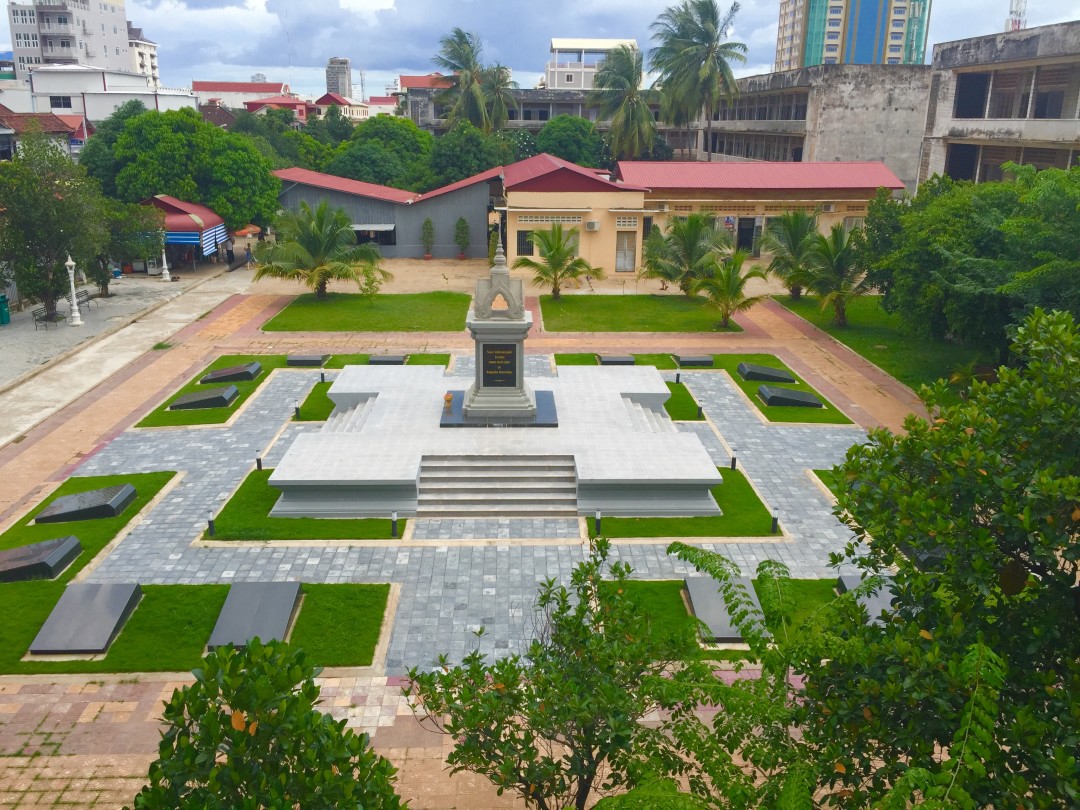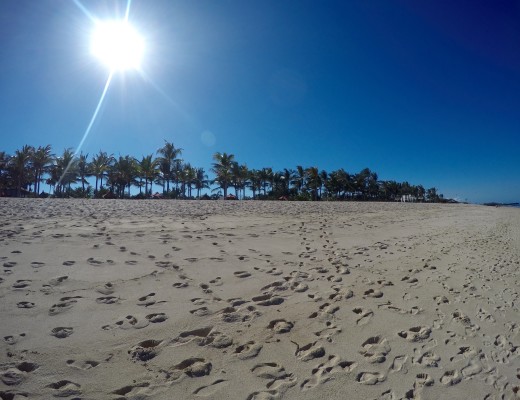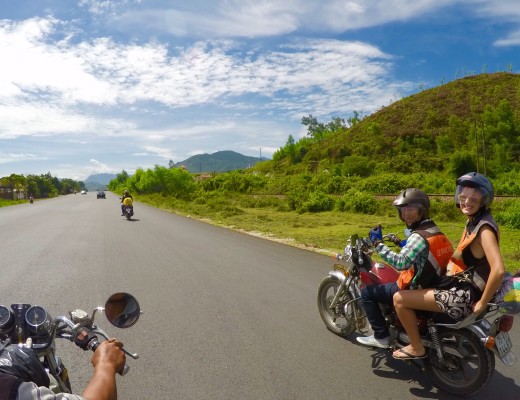Be grateful for every second of every day that you get to spend with the people you love. Life is so very precious
There are some things in life that you will see and you will never forget. You’ll carry those images through your entire life and they will never leave your thoughts. Phnom Penh, the capital city of Cambodia done just that to me. Never have I witnessed such a harrowing and distressing history in just one place. A place where millions of lives were cruelly snatched in the most inhumane and barbaric manner possible.
Imagine living in a world where 1 in 4 people that you knew were callously murdered. Your friends, your family, even your own babies…This is exactly what happened in Cambodia during the relentless ruling of Pol Pots, the leader of the Khmer Rouge – a group of followers of the communist party of Kampuchea.
Pol Pots, a leader who ferociously orchestrated the Cambodian genocide during the years of 1975-1979, was responsible for the 3 million innocent people who lost their lives – almost a quarter of the country’s population, gone…
Gary and I decided to start our Cambodian tour in Phnom Penh for a couple of days. We understood that our stay here would be a difficult one, mainly because our itinerary concentrated primarily on Cambodia’s tragic past. I still cannot believe how ignorant I actually was beforehand. I knew of the genocide only briefly through conversation yet was completely unaware just how merciless it really was.
What those innocent people endured, I cannot even comprehend. It doesn’t bear thinking about, hence why this post has been extremely difficult to write. I did wonder whether or not I should post my pictures however, I feel everyone should be aware of what those people went through and remember them. It may even make you look at your own lives differently. I certainly have opened my eyes more. We are so lucky and sometimes we do forget just how fortunate and privileged our society actually is.
Our first day, we hired a tuk tuk to take us around the city of Phnom Penh. Mony was our driver who was excellent and stayed with us the entire day, whilst Gary and I made our way around the different sites we planned to see. He even stopped and let us have some dinner whilst he took a nap in the Tuk Tuk. It really is the best way to get around in Cambodia and much cheaper than a taxi. Just make sure you negotiate the price beforehand as many will try and rip you off. Thankfully, Mony was a great guy who we even tipped at the end of the day.
Choeung Ek was our first stop of the day, also known as ‘the Killing Fields’ – previously an orchard and now a mass grave where over one million victims were executed by the Khmer Rouge. This area is where trucks would bring thousands upon thousands of innocent people from Toul Sleng Prison (you’ll read more about that later) to be killed. The trucks would arrive 2 or 3 times in a month, then daily towards the end of the genocide. People were dropped here blindfolded, completely unaware of what was happening and led instantly to be executed. Their bodies would be thrown into ditches one after another.
When the number of executions increased to almost 300 daily, detention shelters were created to hold the victims for 24 hours before it was time for them to meet their cruel fate. The structure has now been demolished since the liberalisation however, it was said the building was constructed in a way where prisoners were completely unable to see each other – just to make their last few hours even more terrifying. You can only imagine the fear or being packed in a blackened room unaware of why you were being brought here. Apparently, the victims were told they were being moved to a new prison.
We saw the area where chemicals were stored such as DDT, which was used for two reasons. Firstly, to cover up the stench of dead bodies, and secondly (even more brutal) to help finish the job for victims who had been buried alive in the ditches. The thought of being beaten to (almost) death, then thrown into a pile of bodies and covered in chemicals… How can this have even happened!
We walked further around Choeung Ek, where a mass grave of 450 victims lay. It was completely surreal to see this in real life, it leaves you completely speechless. Many visitors had left offerings on the grave which you can see on the surrounding fence. Other mass graves including one which held 166 headless victims can also be seen. It was truly terrifying to even apprehend the things these people suffered. Rags of clothing belonging to those killed are displayed, you can even see fresh rags surfacing as you walk.
One of the most difficult things to come to terms with was how those millions of poor souls were executed in the most savage and bestial ways possible. To even suggest that shooting would have been more kind demonstrates just how monstrous their enemies were. Bullets were too expensive therefore victims were killed with any implements possible. Many were beaten to death with objects such as digging hoes, hatchets, axes and knifes. Evidence of this can be seen through the skeletal remains, where skulls have been cracked or punched with holes. I was so unaware of how brutal their executions were, even now I feel sick to my very core.
Bones and teeth fragments continue to surface in the Killing Fields as a result of the heavy amount of rain shifting the soils during Cambodia’s monsoon seasons. Every month or so, staff have to collect further remains. We saw many bones scattered around which felt so abnormal. It seemed wrong to put your foot anywhere and again, left us lost for words.
The river area surrounding the fields has never recovered the bodies of the victims. Out of respect, they have been left to lay. As you walk around and listen to the music, written to exemplify the loss of lives, you feel completely heartbroken. It’s an astonishing experience and really just makes you think. The audio speaker you are given upon arrival tells of some of the stories from surviving victims, testimonials from executioners and those part of the Khmer Rouge. I sat by that river and listened to every story, wondering to myself why something so wicked had to happen in the first place.
The Khmer Rouge supported the ideology of agrarian socialism. An act which predominantly applies to non-urbanised and pre-industrial countries. The emphasis is to decentralise themselves and stay away from progressing in terms of social orientation. The Khmer Rouge believed they were purifying the population by avoiding progression. This resulted in the execution of anyone who was educated or professional including members of the military, politics, industry leaders, journalists, students, doctors, and lawyers. Vietnamese and Chinese ethnic groups were also targets and anyone who was a suspected connection with the former government. Even a few Americans, French, British, Australian, New Zealander, Thai and Indian victims were imprisoned and executed.
A large tree stood in the fields where apparently huge speakers hung from it to blast loud music in order to mask the screams of the victims. For the people detained in the shelters awaiting their own fate, they would be unaware as to why this music would play so loudly. We heard a sample of the the final sounds that prisoners would hear and that music combined with the sound of a rickety engine will forever haunt me. Prisoners were forced to listen to this mixture of horrific sounds, even their final thoughts were ripped away from them.
Perhaps the most agonising and grotesque area of the Killing Fields was seeing the tree (known as the killing tree) which was used to kill the babies of victims. It’s an image I cannot even begin to make any sense of. The tree stood next to the mass grave of female bodies who had endured torture and rape before being executed. Their babies were taken from them, held by the feet and smashed against a tree in front of their mothers own eyes. That would be the last image those women would see. Blood and hairs of infants were discovered during the liberalisation. Just sickening…
The Khmer Rouge would kill the entire family of the prisoners to avoid those individuals who could seek revenge. This idea coincided with the Khmer Rouge theory that “clearing grasses, it shall dig its entire root off”. I don’t think I will ever see another sight quite like that for as long as I live…
The final area to see is the large memorial which stands in the centre of Choeng Ek. The memorial is marked by a Buddhist Stupa and made with glass sides which hold over 5000 of the human skulls, exhumed from the graves of the victims. The ages of the victims are marked along with the way they would have died. Many of the skulls have large cracks from axes or holes from metal rods. The deaths are categorised by coloured stickers which completely makes everything even more horrifying to see. It’s a very peculiar place to see as you almost convince yourself it cannot be real, something so immoral and corrupt could not have happened like this. however, it did… and the scars were there to witness, and to remember forever.
The Khmer Rouge were against the idea of societal development. They stated that “study is not important” and education lay in the canals and dams of the land. As a result of this, local schools were turned into prisons, stables and warehouses. The most notorious prison, knows as Toul Sleng Prison (Code name S-21) formally a school, was our next stop in the day. This prison was the most secret of the 196 prisons made.
The prisoners were brought here under false accusations of being involved with crimes such as collaborating with foreign governments, Spying for the CIA or the KGB. Prisoners were tortured through any means possible until they confessed to a crime they did not commit, then were sent to the killing fields, along with their whole family to be killed. This happened to around 20,000 people who were falsely imprisoned here…
Outside, we saw ‘the gallows’, where victims were strung upside down until they lost consciousness, then dunked in smelly cold water to repeat the torture. The Khmer Rouge used any torture means they wanted to make these people confess as they could not bear any more.
The former classrooms were divided into the tiniest cells imaginable to store victims like animals in a cage. The unstable and shoddy brickwork emphasise how quickly those monsters wanted to lock up innocent people. Many were incarcerated individually however, overcrowding meant some of the detention rooms held up to 50 people crammed like sardines. Prisoners were given scraps of food only twice a day and showered together once a month through a freezing cold hose blasting through the holes in the walls.
After seeing thousands of remains, the torture became so real when we saw the thousands of faces from each defenceless individual. Apparently, their height and photo were taken after being arrested, before being thrown into their concrete box. Children were even photographed which was awful to see and look into their sad eyes. Victim’s clothing, including those of children were displayed in the museum, along with weapons used as torturing or killing devices.
Only 7 people survived the genocide… Just 7… who were survivors due to their skills such as art, sculpture, mechanic and translation. One survivor’s story shows how his life was spared as he could paint, therefore was asked to paint a portrait of Pol Pots. Many other pieces or art work can be seen in the museum.
A memorial for the victims stands in the gardens now for us to remember them and the unforgivable and heartbreaking torture they endured. Seeing everything we had seen that day was one of the most heart-rending and poignant experiences I’ll ever have and will certainly never forget. This is not the first genocide and may not even be the last so always remember just how lucky we really are to be alive, healthy and have our families surrounding us. One million people never had that choice. That day made me want to get the next flight home just to give my entire family a hug and say I love them. I hope it will do the same to those reading too…
I did not want to leave this post on a completely depressing note as the city of Phnom Penh should not just be remembered by its tormented past. This striking city also has many remarkable pagodas and temples to discover – not to mention a spectacularly Grand Palace. The city lies on the banks of the mystic Mekong river which makes for a lovely walk. Gary and I spent our second day slightly more upbeat and explored the riverside on foot.
We checked out the central markets right by our hotel and stopped off to have some lunch overlooking the luscious river. Carrying on through the beautiful green parks, we observed monks casually floating around the temples in the most peaceful manner.
The city has a massive cafe and bar culture, serving amazing food and drinks. We found food to actually be surprisingly expensive, due to the preferred currency being the US dollar. We walked forever until we found a reasonably priced cafe called Karma which was really tasty and cheap too! The unpredictable weather hit us hard with an afternoon thunderstorm, so we spent that afternoon chilling out at Karma, making the most of their coffee menu.
Overall Phnom Penh has been quite a mix of emotion. You cannot help but feel sorrow and regret for the city’s grief stricken past. The fact the Pol Pots lived a full life until the age of 72 angers me. The fact that Pol Pot’s was a Cambodian man who caused so much pain to his own people is unforgivable. He married twice and enjoyed his family life whilst taking the lives of others. Some who were too little have even experienced their life…
You cannot deny the fact that the city wants to move away from its past, which is evident through the current city development. Phnom Penh is now seen as a friendly and alluring capital city with multiple attractions. Although many roads remain shabby and some areas are quite rough, you can see the improvements being made. Despite this, Phnom Penh remains the most underdeveloped city in Asia – which to many, can also be seen as quite positive if you’re looking for an authentic experience.
Few colonial French building remain as a result of war and destruction and the city does not favour pedestrians (there are literally no pavements) The true Cambodian atmosphere can only really be felt through the temples and palace buildings, mainly around the riverside area. Beggars are common here which is quite difficult to see. We literally had little children as young as three, run through busy traffic to our tuk tuk, asking for money. Many families live on the streets however, I have heard that this is far more of an issue in Siem Reap… So we will see more of it as that will be our next destination.
I would recommend this city for anyone wanting a true Asia experience. Few westerners can be seen and you feel as if you are trespassing in local territory everywhere you go – except from the touristy riverside. It can be quite scary as many will stare however, keep yourself to yourself and your belongings safe and you’ll be fine. A simple no thank you is enough and you won’t be hassled (too much anyway).
I hope my post has given an insight into what happened to the beautiful country. I apologise for upsetting anyone however, my aim was to show what I had learnt having been so ignorant of Cambodia’s past. The victims should never be forgotten, their families have all gone with them so it’s up to us to keep their memories alive.
Now please go and call your loved ones and tell them how much you care. Then go out and enjoy that precious life you have!
Thanks for reading,
Lots of love
Xx

























































































